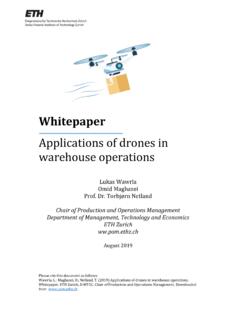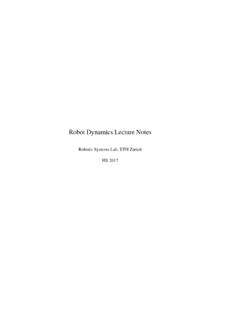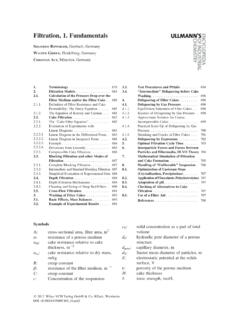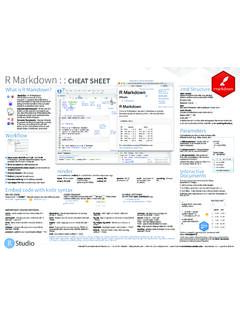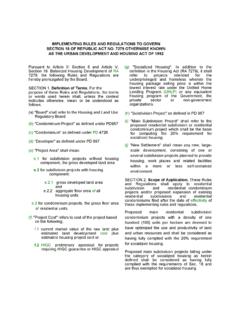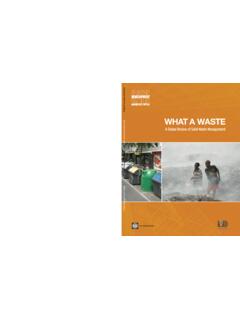Transcription of ETHIOPIA’S LOW-COST HOUSING PROGRAM How Concepts …
1 ETHIOPIA'S LOW-COST HOUSING PROGRAM . How Concepts of Individual Home-Ownership and HOUSING Blocks Still Walk Abroad Sascha Delz1. 1. Department of Architecture, Institute of Urban Design, ETH Zurich / Abstract Addis Ababa's HOUSING sector has been a long-standing challenge. For over a century the rapidly growing Ethiopian capital has been unable to provide adequate and sufficient HOUSING , particularly for its low-income citizens. By the early 2000s, Addis Ababa's 4 million inhabitants stood against an accumulated HOUSING backlog of 233'000 units. Against this backdrop, the Ethiopian government collaborated with the German Technical Cooperation (GTZ) to address the HOUSING issue through a city-wide mass HOUSING PROGRAM .
2 This paper follows the PROGRAM 's successive stages of implementation during the 2000s and addresses the social as well as spatial results along two of its main conceptual pillars: individual home-ownership through a mortgage system, and highly standardized HOUSING block typologies. Whereas the PROGRAM has created amounts of HOUSING units unseen in Ethiopian history, it has also revealed substantial challenges on spatial and socio-economic levels: the PROGRAM has failed to provide wide-spread affordable HOUSING to the targeted low-income groups; it has generated spatial and social segregation; it has fostered dependency on imported materials; it lacks design features and spaces that reflect local lifestyles and daily needs; and it has accelerated the peripheral expansion of the city.
3 In summary, the paper argues that the two described conceptual pillars of mortgage finance and standardized HOUSING blocks have been key catalysts for the described challenges. Based on this, it seems obvious that effective LOW-COST HOUSING Concepts for Addis Ababa whether as alterations or as new approaches would have to specifically engage with design processes and funding schemes from more flexible, versatile and inclusive vantage points. Keywords LOW-COST HOUSING , HOUSING Policy, Development Cooperation, African Urbanization, Ethiopia Biography Sascha Delz holds a Master degree in Architecture and a Doctor of Sciences from ETH Zurich.
4 After practicing as an architect in New York and Switzerland, he worked as design instructor and researcher at the Department of Architecture of ETH Zurich, and the Future Cities Laboratory in Singapore. While his dissertation investigated urban transformations under the premise of international development cooperation in Ethiopia, he currently collaborates on a research project exploring cooperative HOUSING for low-income contexts. Introduction Addis Ababa's HOUSING sector has been a long-standing challenge. For over a century the rapidly growing Ethiopian capital has been unable to provide both adequate and sufficient HOUSING , particularly for its low-income Reflecting the city's general HOUSING history, a series of surveys conducted in accordance with Addis Ababa's master plan revision during the early 2000s, declared a massive shortage of HOUSING units particularly for low-income dwellers and a generally poor condition of the existing HOUSING Over 95% of total HOUSING units were identified as single-story shelters, showing substantial deficits regarding sanitation, cooking.
5 And personal hygiene These challenges have affected both peripheral and central areas: while an estimated 25% of units in the suburbs derive from squatting activities and thus mostly poorly built shelters, almost 60% of the units within the city center were identified as dilapidated, and thus in need of substantial upgrading or total The surveys also identified an existing HOUSING backlog, and a future HOUSING demand: as of 2000, the city had accumulated a HOUSING backlog of 233'000 units and would be in need for additional 223'000. HOUSING units by Against this background, the present government of the Ethiopian People's Revolutionary Democratic Front (EPRDF) reconsidered both past and existing HOUSING policies.
6 Within their most recent efforts of state-led economic development programs and poverty alleviation, the authorities installed for the first time in the country's history a full-scale and operational LOW-COST HOUSING PROGRAM . Scale LOW-COST HOUSING (LCH). However, the full-scale HOUSING PROGRAM was not established from the outset. It emerged from the government's preliminary exploration of more effective and affordable HOUSING construction techniques in the late 1990s. During this search, Ethiopia found the German government as a partner and signed a bilateral agreement for technical assistance in Working with Germany's official development agency German Technical Cooperation' (GTZ), the collaboration's aim was to develop a simple technology to promote HOUSING construction ( ).
7 7 While the subsequent LOW-COST HOUSING ' project (LCH) eventually aimed at a larger scale, its first phase (1999-2002) was predominantly focused on testing HOUSING construction through the so-called LCH technology', and was mainly implemented as two-storied buildings on test sites located in the regional state of Tigray and the city of Addis The LCH technology's main measures to reduce costs and increase efficiency consisted of designing a new and cheaper hollow block size; creating columns without formwork by inserting reinforcement inside the hollow blocks, combining both strip and slab foundations, and introducing a pre-fabricated formwork-free slab system using beams and hollow Overall, this resulted in construction costs of ETB 500-800 (USD 59-95) per square meter, a 40% reduction of average building costs in Ethiopia at the 1.
8 Before the present administration's efforts, both major preceding governments Haile Selassie's Monarchy and Mengistu Hailemariam's Derg Regime' failed to install a comprehensive, effective HOUSING policy as well. See for example: Grima Kebbede, The State and Development in Ethiopia (New Jersey & London: Humanities Press International, 1992). ; Zelleke Zewdie, A Review of Experiences in LOW-COST HOUSING Provision in Ethiopia (Addis Ababa, 1997). 2. See: ORAAMP, Structure Plan HOUSING Component - Improvement and Development Strategy: Guidelines, Regulations, Norms and Standards (Addis Ababa, 2001).
9 3. ORAAMP, Assessment of Addis Ababa's HOUSING Sector - Key Areas of Intervention, Strategies & Policy Measures for a HOUSING Policy. 4. ORAAMP, Structure Plan HOUSING Component - Improvement and Development Strategy: Guidelines, Regulations, Norms and Standards. 5. Ibid. For the calculations see: 6. See: GTZ and Ministry of Federal Affairs (Ethiopia), Low Cost HOUSING - Technical Manual (Addis Ababa: GTZ, 2003). 7. GTZ, "Low Cost HOUSING - Major Order for HOUSING Construction," in Akzente - Working with GTZ / Special Issue - Urban Management, 2005 (Eschborn: GTZ). The GTZ has been renamed to GIZ (German International Cooperation) in 2007.
10 Since all activities and documents regarding the Ethiopian HOUSING PROGRAM have occurred under this former name, the old acronym GTZ will be used throughout the text. 8. See: GTZ and Ministry of Federal Affairs (Ethiopia), Low Cost HOUSING - Technical Manual. 9. A hollow block is an extruded, air-dried cement brick, leaving large chambers hollow within the brick, and thus making it lighter and more affordable See: ibid. 10. See: ibid. Currency conversions are based on the average exchange rate of the corresponding year (historical exchange rates obtained from ). 2. Scale Addis Ababa Grand HOUSING PROGRAM (AAGHP).


